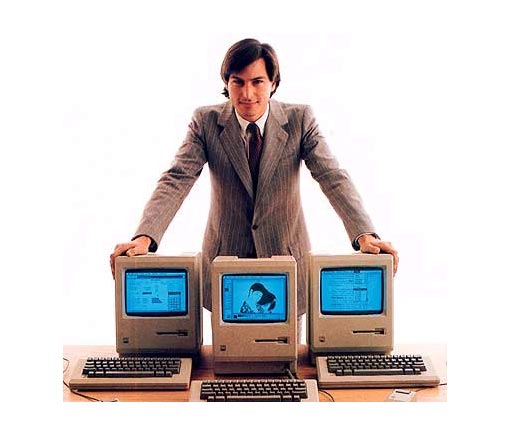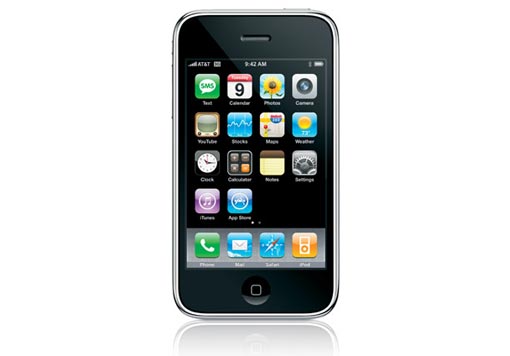You are hereBlogs / WcP.Scientific.Mind's blog / 25 years of innovation: Apple's unveiling of the first Macintosh forever changed the future of personal computing
25 years of innovation: Apple's unveiling of the first Macintosh forever changed the future of personal computing

(quote)
The Macintosh - the first to bear the name - turns 25 on 24 January. The machine debuted in 1984 and kicked off a product line that were Apple's flagship computers for many years.
The Macintosh helped popularize the combination of graphical interface and mouse that is ubiquitous today. It had a revolutionary all-in-one design, and crucially, used a graphical user interface to navigate around, rather than text commands. This enabled the Apple Macintosh to cross the species barrier – everyday users could now use the computer, rather than just geeks au fait with scripting and coding. Indeed, the $2,495 price tag was perhaps the only barrier to entry.

The mouse input system and simple GUI enabled users to carry out a range of tasks that had been impossible on other computers. The Apple Macintosh came bundled with two software programs, MacWrite and MacPaint, signalling the birth of word processing and desktop publishing. With just 128KB of memory and a sloth-like 8MHz processor, the Apple Macintosh is woefully underpowered by today’s standards, but was cutting edge at the time.
For Apple, the launch of the Apple Macintosh was a significant event, and sent a clear signal to rivals such as Microsoft and IBM that it meant business. Fascinating insights into the development of the first Macintosh are collated on the Folklore website (www.folklore.org).

Although Microsoft had launched its operating system - MS DOS - in 1981 it was not until 1985, a year after the Macintosh made its debut, that it introduced its own GUI, Microsoft Windows. However, this did not enjoy significant popularity until the advent of Windows 3.x in 1990.
Unfortunately, Apple found its early success difficult to sustain in later years. Steve Jobs parted company with Apple the following year after a power struggle with the board of directors, and for the next decade, the company struggled to build on the foundations laid by the Apple Macintosh. A succession of chief executives slowly diluted the Apple brand, taking the company on ill-fated forays into a number of other product lines, including a confusing range of new Macintoshes that failed to capture the public imagination. Although Apple had orchestrated the successful launch of the Apple Macintosh, it had also been responsible for the much-maligned Apple III (the top model of which cost $7,800, despite the machine’s lack of compelling software), and the Apple Lisa (which gained a reputation for being slow and clunky, and failed to win over business customers, who instead opted for IBM’s machines).

The company made the error of licensing its operating system to third parties, and competitors sound found ways to produce faster, better specked machines sold at lower prices than Apple could manage. Apple was losing its focus and its momentum; the good groundwork laid by the Apple Macintosh was being slowly undone. Consumers and developers who had been won over by Apple’s earlier efforts were starting to drift back to Windows. Apple faced significant financial losses, and even the spectre of bankruptcy. “It lost its momentum in the enterprise,” said Brian Clift, a former Apple engineer. “The value proposition in the products suffered and it really diluted the brand.”
In 1997, Steve Jobs rejoined Apple as chief executive, and a dramatic transformation in the company’s fortunes occurred. Jobs, currently on a leave of absence from Apple following persistent health problems, used his vision, business acumen, eye for detail and formidable negotiation skills to revive the Apple brand – starting, naturally enough, with Macs. The software he’d developed with NeXT, the computer company he’d founded during his Apple hiatus, became the starting point for the Mac OS X operating system.

The Macintosh range gradually evolved from dull beige boxes to design icons in their own right, with the 1998 launch of the iMac – instantly recognizable for its translucent, multicolored monitors – a turning point in the company’s fortunes. Apple began to build a reputation not only for solid and easy-to-use software but for beautiful gadgets.
In January 2007, Apple changed its name from Apple Computers to simply Apple Inc. It reflected a widening focus for the company, and an acknowledgement that cutting-edge gadgets, such as the iPhone and iPod, were helping to bring its technology to a wider audience, and in turn driving consumers to discover other Apple products – even those who would never previously have considered switching to a Mac.

While Microsoft remains the dominant player in the home computer market, with Apple enjoying a comparatively paltry 10 per cent share, there’s no doubt Apple’s star is in the ascendency. The recent “I’m a Mac, I’m a PC” advertising campaign riffed on stereotypes, prompting Microsoft to launch its own “I’m a PC” ad campaign as a counterpoint.
Although the tech community is getting dewy-eyed at the silver anniversary of the Mac, Steve Jobs remains characteristically unmoved. His focus is on looking to the future, not the past. “When I got back here in 1997, I was looking for more room, and I found an archive of old Macs and other stuff,” he recalls. “I said, ‘Get it away!’ and I shipped all that s*** off to Stanford. “If you look backward in this business, you’ll be crushed. You have to look forward.”
(unquote)
Photos courtesy of Apple and AP
Original Source: eWeek, BBC, and The Telegraph
Related Articles: 25 milestones from 25 years of the Mac, 20 most important people in the history of the Mac, The making of Macintosh, Successes, regrets, Apple’s had a few, The top 10 standout Macs, Tech Weekly special: How the Mac was made, and Apple Macintosh: A 25 Year History



















I just wanted to thank you for taking the time to create this article and share it. There was a lot of good information.
What stood out to me was when Steve joined back in 1997 and the company then saw a massive shift. Crazy what one person can do for an entire company.
I look forward to reading more of your articles.
Although the tech community is getting dewy-eyed at the silver anniversary of the Mac, Steve Jobs remains characteristically unmoved. His focus is on looking to the future, not the past.
very good article
Great Articles. Thank's for sharing. https://googlecabservice.com">Car Rental in India
Thanks for sharing this nice article it have some great useful blog....
Thanks for this blog is very useful i want to read again and again...
Technology has evolved a lot since 1984. Although not many of us remember the first computers, they revolutionized the market at that time. Now things have changes, we use https://www.voicewareservers.com/">digital voice recorders and smartphones on a daily basis. Gadgets make our lives easier, so why not take advantage of them?
Thanks for sharing this nice article. and i wish to again on your new blog keep sharing with your article.
Thanks For Share....
I'm a big fan of Apple's. It's amazing how they could play with the technology.
This is the biggest company in the computers industry in my opinion. I read on https://www.activextest.com/">www.activextest.com about the raising number of apps available for the iPhone and iPad. The way this company evolved and they changed the way we see the computer today is simply amazing.
I wonder if Apple's legacy and future will be at their best now that Steve Jobs passed away. His vision and everything that he had done really changed the way we see computers and phones today. So the team back there at Apple will really have to stick on the https://www.trendmicro.com/us/enterprise/security-management/vulnerability-management-services/index.html>Vulnerability Management to try to make the team be as good and great as before.
The history of Apple is fantastic. Steve Jobs started from nothing, he even didn't graduate and look how far he went. I am a big Apple fan, I am the proud owner of an iPhone and an iPad. Buying apps it's my favorite hobby. I recently purchased https://www.scalematrix.com/">AppLogic From Scalematrix but mostly I am interested in strategy games.
Beginning with version 10.5 "Leopard" in late 2007, Mac OS X has shipped with native virtual desktop support, called Spaces, which allows up to 16 https://www.enpointe.com/hosted-virtual-desktop">hosted virtual desktop. It allows the user to associate applications with a particular "Space". As of Mac OS X 10.7 "Lion", this functionality has been moved into Mission Control. Scrolling desktops were made available to Macintosh users by a 3rd party extension called Stepping Out created by Wes Boyd (the future founder of Berkeley Systems) in 1986.
This is one of the biggest company in the computers industry in the world. Thanks For Sharing such a beautiful article. Also Heavy Use of Computers can cause sleep issues. To treat sleep issues Buy https://www.mylocalpharma.com/modafinil-100mg.aspx">Modafinil Online.